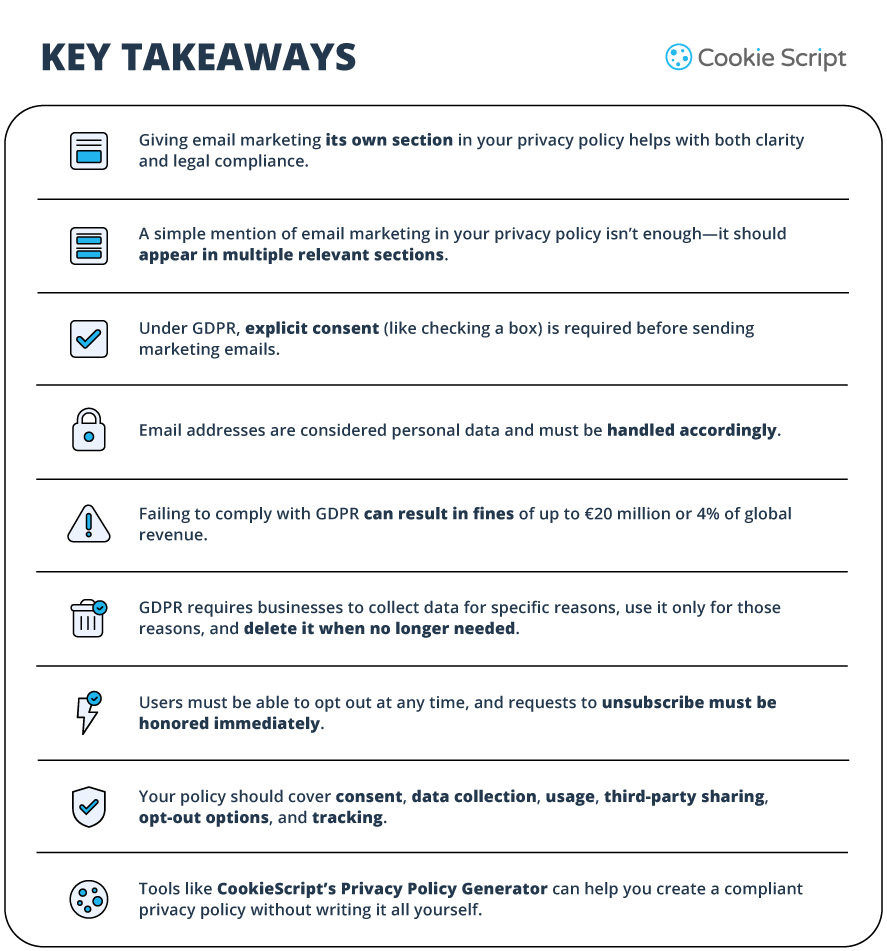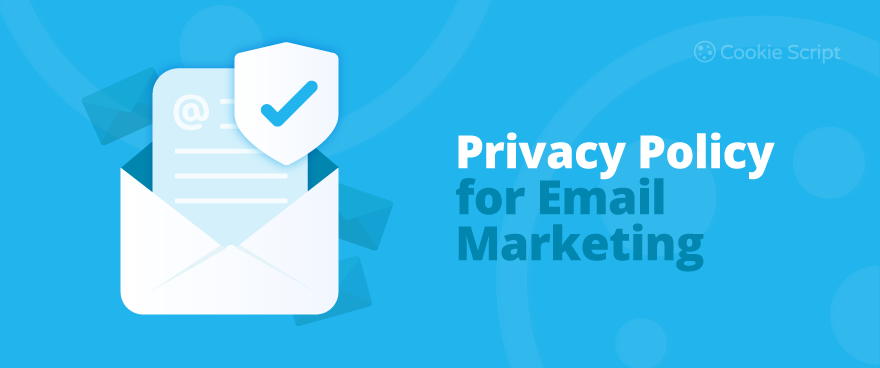This article covers why a Privacy Policy for email marketing is essential, which laws require one, the penalties for non-compliance, and more.

Do You Need a Privacy Policy for Email Marketing?
Running email marketing campaigns means you're working with personal data. For this reason, you must clearly explain how you're using said data in connection with your marketing efforts.
A quick mention that you send emails with consent won't cut it. Email usually involves tracking how people interact with your messages, which adds extra layers of data processing.
If you're using email marketing, it’s not enough to mention it once in your Privacy Policy and call it a day. It should appear in several different spots throughout.
For example, you’ll want to touch on:
- The kinds of Personal Information you collect
- Where and how that data is gathered
- Any tools you use to track behavior, like cookies, automatically
- How users can unsubscribe or manage their email preferences
Giving email marketing its own section is a good idea to keep things clear. That way, anyone reading your Privacy Policy can easily understand what you’re doing with their information, and you will stay on the right side of privacy laws while you're at it.
What Does GDPR Say About the Privacy Policy for Email Marketing?
If your site or service is accessible to people in the EU, the General Data Protection Regulation (GDPR) applies to you even if you're not based there. You must comply unless you're actively blocking EU visitors. And yes, that includes how you handle email marketing.
Since 2018, email marketers have had to adjust a fair bit under this regulation. The biggest shift? Consent.
Consent must be an explicit action. For example, someone ticking a box to say "yes" to your emails counts, but pre-checked boxes or vague "by signing up, you agree" language doesn't cut anymore.
In addition to GDPR, similar regulations exist in other regions of the world. In the USA, there is the California Consumer Privacy Act (CCPA), Connecticut Privacy Act (CTDPA), Colorado Privacy Act (CPA), and other privacy regulations. privacy laws also exist in Brazil (LGPD), Canada (PIPEDA), and other countries.
Penalties for GDPR Violation in Email Marketing
When it comes to email marketing, GDPR violations are costly and sometimes - staggering.
The regulation sets out two levels of fines, depending on how severe the violation is:
- Serious breaches, such as violating core privacy principles or mishandling user data, can result in fines of up to €20 million or 4% of the company's global annual revenue (whichever is higher).
- Administrative errors, such as failing to report a breach or keep adequate records, can result in penalties of up to €10 million or 2% of the company's global annual revenue (whichever is higher).
These aren't small numbers, especially for businesses with slim margins, so let's look at how this plays out in the real world.
In 2019, British Airways initially faced a massive fine of £183 million after a data breach revealed serious flaws in its security systems. Luckily for the company, the fine was later reduced to £20 million.
Another example is Amazon, which was fined €746 million for GDPR violations tied to its advertising handling. Meta also hasn't fared much better. In 2023, it was fined €1.2 billion over improper data transfers and another €251 million in 2024 for a years-old breach.
Small and medium-sized businesses aren't off the hook either. The fines may scale based on revenue, but a few million euros can devastate a small company. Just one major compliance failure could cost them everything.
Individuals can also be fined. For example, a German police officer was fined €1,400 for accessing personal data without a valid reason. So yes, even a single person misusing data can face legal consequences.
How To Ensure GDPR Compliance In Your Marketing Emails?
GDPR changed the rules around collecting and handling email addresses as well as other personal data. To play by the GDPR book, you need to:
- Collect data only when you've got a legitimate, clearly defined reason
- Use it only for that purpose no bait-and-switch
- Give users a way to fix or update their info if needed
- Delete the data once you don't need it anymore
Once someone is on your email list, you can't just forget about them. You'll need to clear out old addresses, handle unsubscribe requests in a timely manner, and be upfront about what you're doing with their information.
Also, GDPR gives people the right to opt-out at any time and refuse to provide their data for marketing even if they previously agreed to it. If they do, that's the end of it. There will be no debates, no delays—you just have to stop.
Tips for Creating Your Email Marketing Privacy Policy
A Privacy Policy can show subscribers you're trustworthy, transparent, and not sketchy with their data. Here's what to include:
Make sure they actually said "yes"
There should be no shady pre-checked boxes. People should knowingly opt into your emails by clicking a checkbox, filling out a form, or confirming their subscription. If it's not a clear "yes," it's a no.
Tell them what you're collecting
Emails, names, maybe a birthday if you're sending discounts, whatever it is, just say so. Being upfront here can save you awkward questions (or legal headaches) later.
What are you doing with the info?
Sending weekly tips? Promo deals? Occasional dog pictures? Fabulous! Just be specific. People want to know what they're signing up for, not guesswork.
Who else is touching this data?
If you're using platforms like Mailchimp, Klaviyo, or any service that helps send emails or manage your list, mention them. You don't need a novel, just a heads-up on who's involved.
Let them leave easily
If someone wants out, don't make it a scavenger hunt. Include an unsubscribe link or a quick way to contact you. Bonus points if it's painless.
Don't hoard their data forever
Nobody wants their email address floating around in some forgotten list from 2013. Explain how long you keep personal info and how someone can ask you to delete it.
Mention any tracking stuff
Are you using open-rate trackers or click-through pixels? Let them know. If there's a way to opt out of that kind of tracking, include it.
Follow the law (seriously)
Whether you're subject to GDPR, CAN-SPAM, or other regional rules, make sure your policy aligns with whatever applies to your audience. It's not just about compliance; it's also about showing you care.
You don’t have to do it yourself
A Privacy Policy sounds like one of those things you’ll “get to later,” especially if you’re unsure which laws apply or don’t have the time. Understandable. That’s why tools like the CookieScript Privacy Policy Generator exist.
Instead of digging through regulations, you get a flexible template that covers GDPR, CCPA, and others you probably don’t want to read up on.
Oh, and CookieScript isn’t just some random generator. It’s on Google’s list of certified CMPs (Consent Management Platforms), so you know it’s legit.
If you're curious, you can register for free or check out their pricing plans to see what fits your needs.
In 2024, CookieScript Consent Management Platform (CMP) was nominated as the best CMP on G2.
Frequently Asked Questions
Can I create my own Privacy Policy?
Yes, you can. There’s no specific rule about how a Privacy Policy must be written as long as the final version complies with applicable privacy laws. That means you can draft it yourself or use platforms like CookieScript to generate it for you.
Is an email address considered personal data under the GDPR?
It is. Laws like the GDPR and CCPA classify email addresses as personally identifiable information (PII). That’s because an email can, on its own or alongside other data, be used to pinpoint an individual.
What information should go into a Privacy Policy?
A proper Privacy Policy must clearly describe how personal data is collected, what it’s used for, and whether it’s shared and with whom. This applies whether the data is gathered directly through your site or external services. Transparency and plain language are key.
Where should a Privacy Policy be placed?
Once your Privacy Policy is ready, it must be easy to find. Make sure it's visible wherever you ask users to submit personal information, like sign-up forms or checkout pages. It’s also smart to include links in places where people typically look for legal info, such as footers or terms and conditions sections.
Is it legal to track emails under GDPR?
GDPR requires that any collection of personal data, including email engagement (like opens or clicks), happen with clear, informed permission from the user. There is no sneaky tracking. People must agree to it first.
